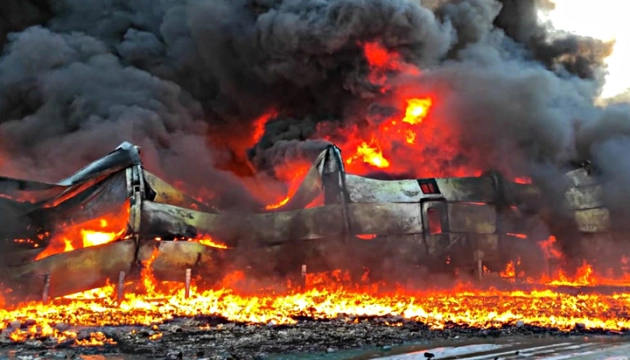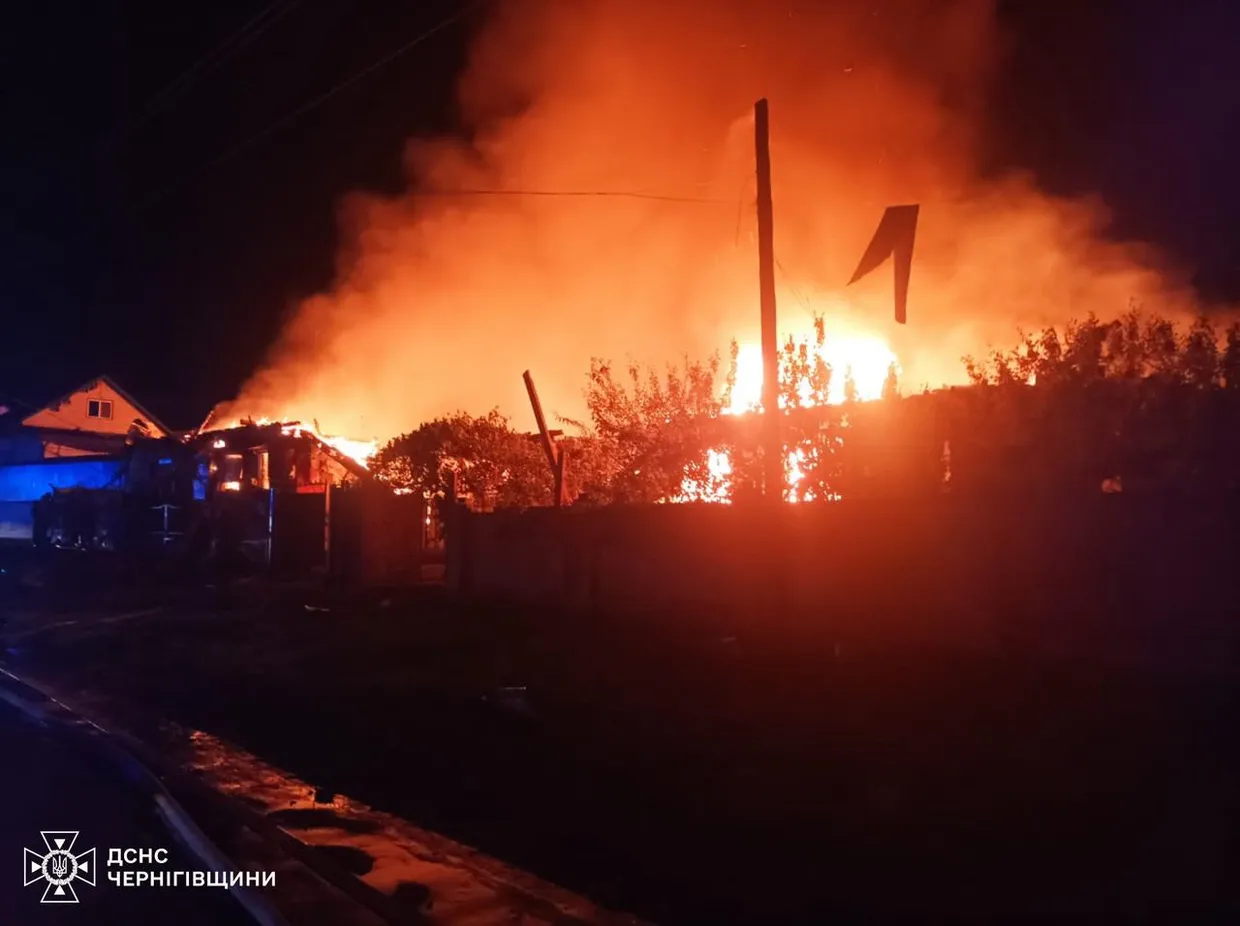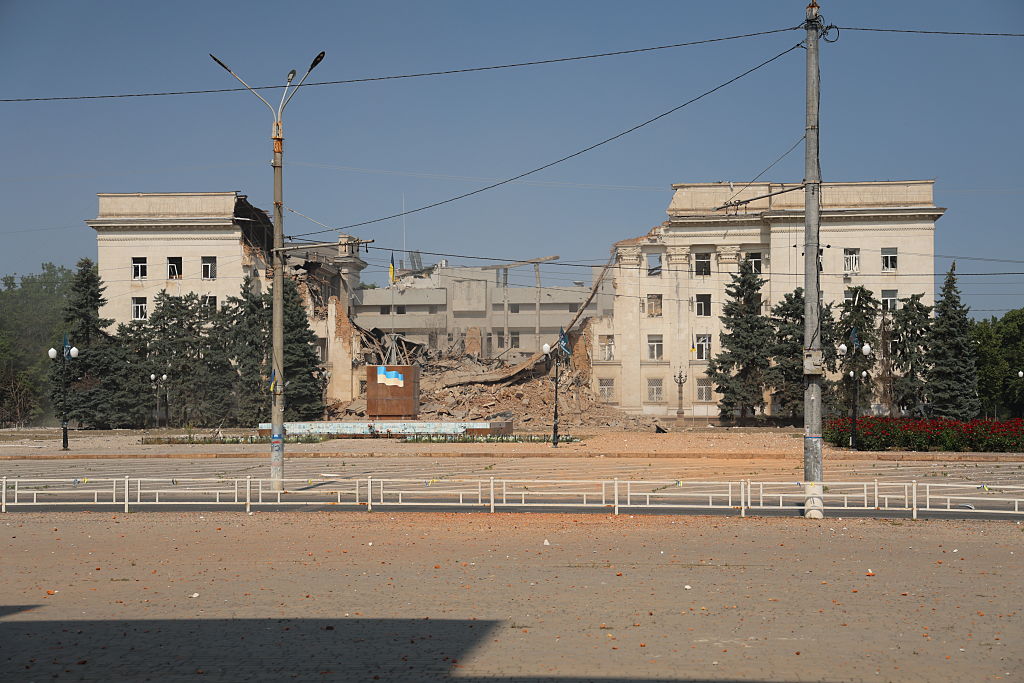As Trump Privately Calls Operation Spiderweb “Badass” While Publicly Urging Restraint, Russia Promises Retaliation That Won’t Be “Pretty”
Summary of the Day – June 5, 2025
The contradictions of power played out in stark relief on June 5, as President Donald Trump privately praised Ukraine’s devastating drone strike on Russian bombers as “badass” while publicly warning of Russia’s promised retaliation. Behind closed doors, Trump reportedly admired the audacity of what one adviser described as a “chihuahua” successfully attacking “a much bigger dog.” Yet in public, the American president continued his increasingly detached rhetoric about letting two fighters “go for a while” before intervention. Meanwhile, Ukraine’s forces struck another Russian missile base in Bryansk Oblast, destroying Iskander launchers that had been preparing to attack Kyiv, while Russian drones killed five civilians including a one-year-old child in Chernihiv Oblast. As diplomatic deadlines remain locked “in Trump’s brain” and Russia threatens retaliation for Operation Spiderweb, the gap between private admiration and public policy reveals the complex calculus of a war where small nations can still bloody superpowers.
The President’s Private Praise Meets Public Detachment
Behind the walls of the White House, Donald Trump’s reaction to Ukraine’s Operation Spiderweb told a different story than his public statements suggested. According to sources familiar with his private conversations, the American president described Ukraine’s drone strike on Russian strategic bombers as both “strong” and “badass”—a far cry from his public warnings about escalation.
“He thought it was badass,” one source told Axios, while another confirmed Trump had told a confidant the strike was “pretty strong.” The enthusiasm extended to Trump’s inner circle, where one adviser drew a vivid comparison that captured the operation’s David-versus-Goliath nature, using the metaphor of a “chihuahua” attacking “a much bigger dog.”
This private admiration stands in sharp contrast to Trump’s public posture during his meeting with German Chancellor Friedrich Merz, where he compared the Ukraine war to children fighting in a park or hockey players brawling on ice. “Sometimes you see two young children fighting like crazy,” Trump said. “They hate each other, and they’re fighting in a park, and you try and pull them apart. They don’t want to be pulled. Sometimes you’re better off letting them fight for a while and then pulling them apart.”
The analogy extended to sports: “You see it in hockey. You see it in sports. The referees let them go for a couple of seconds. Let them go for a little while before you pull them apart.” This philosophy represents a fundamental shift toward positioning himself as a neutral arbiter waiting for the optimal moment to intervene—a stance that risks prolonging a conflict where civilians die daily.
The analogy actual falls apart, because if you saw a 6th grader on the playground beating up a 1st grader to the point of death, you would be morally required to step in and save the younger child.
The Deadline in His Brain: Sanctions Threats Without Specifics
When pressed by reporters about his timeline for imposing additional sanctions on Russia, Trump offered only cryptic assurance: “Yes, it’s in my brain the deadline.” The president refused to specify a date, adding only that “when I see the moment where it’s not going to stop… we’ll be very tough.”
This mental deadline represents the latest in a series of increasingly vague ultimatums from an administration that has repeatedly threatened consequences while avoiding specific commitments. Trump’s reluctance stems partly from his continued hope for a breakthrough: “If I think I’m close to getting a deal, I don’t want to screw it up by doing that,” he explained.
Meanwhile, a bipartisan sanctions bill with overwhelming support—backed by 82 of 100 senators—awaits Trump’s decision. The legislation would impose a 500% tariff on imports from countries purchasing Russian oil and raw materials, but Trump requested that the Senate delay voting until he reviews the measure. “I have to take a look. (Senators) are waiting for me to decide what to do. And I will decide. Maybe very soon,” Trump said, while emphasizing that senators “will be guided by my instructions.”
Strike and Counterstrike: Ukraine’s Expanding Long-Range Campaign

Ukrainian forces demonstrated their expanding capability with a precision missile strike on Russian Iskander launchers near Klintsy in Bryansk Oblast. The attack destroyed one launcher and seriously damaged two others belonging to Russia’s 26th Missile Brigade—forces that had been preparing to launch strikes against Ukrainian cities, likely including Kyiv.
“Thanks to effective reconnaissance and the coordinated efforts of the Armed Forces and the Security Service of Ukraine, the targets were successfully hit,” the General Staff reported, noting no civilian casualties in the operation. The timing proved crucial—the Russian missile unit was caught in the act of preparing to fire, suggesting Ukrainian intelligence had real-time visibility into Russian military activities.
The strike represents Ukraine’s continued effort to degrade Russia’s offensive capabilities at their source, implementing a proactive defense strategy that shifts the battlefield dynamic from reactive air defense to offensive counter-battery operations. This came as part of a broader Ukrainian campaign targeting Russian military infrastructure across multiple regions.
Overnight on June 6, Ukrainian forces conducted coordinated strikes across Russian territory, hitting the JSC Progress Plant in Michurinsk, Tambov Oblast, which produces aviation and missile control systems. The Kristal oil refinery in Engels, Saratov Oblast, was engulfed in flames—a facility that supplies fuel to the strategic Engels-2 military airfield housing nuclear-capable bombers regularly used against Ukrainian cities.
Additional strikes disrupted Russian logistics, with a train derailment in Belgorod Oblast after an explosive device detonated under the tracks, and an explosion on a rail line in Voronezh Oblast disrupting travel for at least 19 passenger and commercial trains. Russian officials claimed air defense units intercepted 174 Ukrainian drones across 12 regions, though these figures could not be independently verified.

Russia’s Repair Claims and Retaliation Promises
Russian Deputy Foreign Minister Sergei Ryabkov attempted damage control on June 5, claiming that bombers struck during Operation Spiderweb were “not destroyed but damaged” and would be “restored.” The assertion comes as Moscow seeks to minimize the psychological impact of Ukraine’s most successful aviation strike of the war.
“The equipment in question, as was also stated by representatives of the Ministry of Defence, was not destroyed but damaged. It will be restored,” Ryabkov told TASS, though he provided no timeline for the alleged repairs. The claims stand in stark contrast to satellite imagery from Belaya airbase, which shows clear evidence of destroyed Tu-95MS strategic bombers and Tu-22M3 aircraft.
President Volodymyr Zelensky offered a more realistic assessment, stating that roughly half of the damaged planes would be impossible to repair, while others would require significant time to return to service. The complexities of Soviet-era technology, combined with sanctions-related supply chain challenges, make rapid restoration unlikely.
Russia’s promised retaliation materialized overnight on June 6, deploying 452 drones and 45 missiles in a massive assault that killed four people in Kyiv and caused casualties across western Ukraine. The attack fulfilled Putin’s warning to Trump that Moscow would respond to Ukrainian strikes on Russian airfields. Air raid alerts activated across all Ukrainian regions as Tu-95MS strategic bombers launched cruise missiles alongside Iranian-designed Shahed suicide drones.
Multiple fires erupted across Kyiv as drones struck residential buildings and civilian infrastructure. The capital’s mayor reported at least four deaths and 20 injuries, with attacks damaging apartment buildings in five districts and disrupting metro operations. In Ternopil, Russian forces struck infrastructure with drones and cruise missiles, injuring five people and cutting electricity to parts of the city. Lutsk reported five injured residents after attacks with 15 drones and six missiles.
The Price of Defiance: Civilian Casualties Mount
The human cost of Moscow’s campaign became tragically clear in northern Ukraine, where a Russian drone attack on Pryluky overnight killed five civilians, including a one-year-old child found beneath the rubble alongside two women. Nine others were injured in an attack that destroyed homes and sparked fires across residential neighborhoods.

Chernihiv Oblast Governor Viacheslav Chaus confirmed that at least six Iranian-designed Shahed-136 drones were used in the assault on this city of roughly 51,500 people. The attack completely destroyed two residential buildings, two garages, a farm building, and a car. Emergency crews worked through the night to extinguish fires and search for survivors, with six people hospitalized including a 5-year-old child.
In southern Ukraine, Russian forces launched high-explosive guided aerial bombs at central Kherson, hitting and partially destroying the Regional State Administration building. Four bombs struck the city center within fifteen minutes, causing significant damage to the government complex that had been repeatedly targeted since Ukraine’s liberation of the city. “Within just fifteen minutes, four Russian bombs hit this location,” Governor Oleksandr Prokudin reported, noting additional damage to residential buildings and educational institutions.

Industrial Warfare: The Drone Production Race
Russian intelligence reveals Moscow’s massive escalation in drone warfare, with plans to produce two million first-person-view drones and 30,000 long-range drones in 2025. The Ukrainian Foreign Intelligence Service disclosed these figures as evidence of Russia’s commitment to overwhelming Ukrainian defenses through sheer volume.
“They aim to produce about 30,000 long-range drones of those types plus 30,000 false target drones they use to exhaust Ukrainian air defenses in 2025,” spokesperson Oleh Aleksandrov told Politico. “As for the FPV drones, Russians are aiming to produce a whopping 2 million of them.”
The production surge relies heavily on Chinese components supplied through shell companies designed to evade sanctions. Despite Beijing’s public denials, Chinese manufacturers continue providing key electronics and technologies that enable Russian drone production.
Ukraine has responded by dramatically scaling its own drone capabilities, more than doubling long-range drone output in 2024 compared to 2023—a 22-fold increase over 2022 levels. The race reflects both sides’ recognition that drone warfare will likely determine the conflict’s outcome.
Battlefield Dynamics: Grinding Advances Amid Massive Casualties
Russian forces continue sustaining devastating casualty rates for minimal territorial gains, with NATO officials reporting an average of 1,140 Russian personnel losses daily. Of these, nearly 975 are killed in action—far exceeding the typical one-to-three killed-to-wounded ratio seen in conventional warfare.
Russian forces suffered approximately 160,000 casualties from January to April 2025, with Ukrainian officials reporting about 177,000 casualties since January 1. These losses produced minimal territorial results—Russia seized only 0.4 percent of Ukraine’s territory in 2024 and just 0.2 percent in 2025, suffering roughly 167 casualties per square kilometer of advance.
On June 5, Russian forces made limited confirmed advances near Kindrashivka north of Kupyansk, southeast of Zelena Dolyna north of Lyman, and in multiple locations around Toretsk. Ukrainian forces countered with marginal advances southwest of Myrne in the Hulyaipole direction. The pattern reflects the war’s current dynamics—massive Russian personnel expenditure for minimal gains, while Ukrainian forces focus on degrading Russian capabilities through precision strikes.
International Support: Ramstein Commitments and European Resolve
The Ukraine Defense Contact Group meeting in Ramstein demonstrated that international support remains robust despite American ambivalence. European allies announced billions in new aid commitments, reflecting their determination to sustain Ukraine regardless of shifting American priorities.
The Netherlands led with a 400-million-euro package focused on naval capabilities, including over 100 vessels and 50 naval drones. Belgium announced one billion euros annually through 2029, while Norway pledged $7 billion for 2025 alone, including $700 million specifically for drone production. Canada contributed $45 million for drones, electronic warfare equipment, and armored personnel carriers.
Defense Minister Rustem Umerov unveiled the “Ramstein Investments in the Defense Industry” initiative, allowing Ukrainian companies to establish joint production facilities with partner nations. The program prioritizes Ukrainian military needs, ensuring all output goes to Ukrainian forces while the war continues.
Simultaneously, the Black Sea Security Forum 2025 convened in Odesa’s National Opera House despite ongoing Russian missile threats, bringing together hundreds of participants including ambassadors, former Prime Ministers, and NATO officials. “Odesa is crucial, we want to send a signal,” said Maximilian Rasch, Deputy Ambassador of Germany to Ukraine. The forum highlighted the city’s dual role as Ukraine’s maritime capital and an emerging Black Sea security hub.
Diplomatic Maneuvering and Alliance Fractures
Slovakia’s parliament passed a non-binding resolution urging the government to oppose any new international sanctions against Russia, citing alleged negative economic impacts. The measure, backed by 51 of 76 lawmakers present, reflects growing pro-Russian sentiment within Slovakia’s ruling coalition and could complicate Brussels’ efforts to maintain consensus on future sanctions packages.
Since taking office in 2023, Prime Minister Robert Fico has reversed Slovakia’s previous pro-Ukraine stance, ending military aid and questioning EU sanctions effectiveness. While lacking legal force, the resolution signals potential friction in European unity.
Meanwhile, the European Union reimposed tariffs on Ukrainian agricultural exports on June 5, marking the first time since Russia’s invasion that Brussels declined to renew trade barrier suspensions. The decision reflects mounting pressure from eastern European farmers who claim Ukrainian products are overwhelming local markets. The Ukrainian Agribusiness Club estimates losses of up to 1.1 billion euros in 2025, rising to 3.3 billion euros in 2026 without a new agreement.
President Trump nominated Air Force Lieutenant General Alexus Grynkewich as the next Supreme Allied Commander Europe, reaffirming American leadership of NATO’s military structure despite earlier speculation about potentially relinquishing this traditionally American role. The decision provides short-term reassurance to European allies while Trump continues pressing for increased defense spending.
Intelligence Wars and Information Control
The Security Service of Ukraine exposed a disturbing escalation in Russian intelligence operations: operatives now impersonate SBU officials to recruit Ukrainian civilians for sabotage. This “false flag” technique involves contacting citizens via messaging apps, claiming to be SBU investigators conducting official inquiries into fabricated criminal charges.
Victims are then pressured into carrying out surveillance, courier duties, fund transfers, or more serious tasks including purchasing explosive materials and conducting sabotage against government buildings. The operation particularly targets elderly Ukrainians, expanding beyond earlier efforts that focused on teenagers.
On the Russian side, law enforcement detained three employees of state-owned Ural regional information agency Ura.ru after searching the publication’s editorial office in Yekaterinburg. Authorities claimed the investigation relates to alleged foreign agent funding, though Ura.ru has notably reported on Russian military command changes ahead of official announcements. The crackdown reflects the Kremlin’s increasing sensitivity about military information and command structure reporting.
International Pressure and Religious Diplomacy
Russian President Vladimir Putin used his first phone call with Pope Leo XIV to advance Moscow’s narrative about religious persecution in Ukraine, requesting Vatican support for what Russia described as freedom of religion, specifically for the Moscow-linked Ukrainian Orthodox Church. The irony was stark: Russia, which has systematically destroyed hundreds of Ukrainian churches and killed dozens of priests, now positions itself as a defender of religious freedom.
Pope Leo XIV urged Russia to make “a gesture that would favor peace” and emphasized dialogue’s importance, encouraging prisoner exchanges and the return of fallen soldiers’ remains. The call reflects Putin’s broader effort to portray Russia as reasonable while Ukraine remains intransigent.
North Korean leader Kim Jong-un reaffirmed his country’s “unconditional support” for Russia’s war effort during a June 4 visit by Russian Security Council Secretary Sergei Shoigu. The meeting underscored the deepening military cooperation between Moscow and Pyongyang, with North Korea reportedly receiving technological assistance and economic support in exchange for artillery shells and missiles used against Ukrainian targets.
Brazilian President Lula da Silva reiterated calls for peace, urging Russia to restrain attacks on Ukraine as Putin has vowed to “respond” to Operation Spiderweb. “I said (to Putin) it’s time to open our eyes and to put an end to the insanity of war, which destroys everything and builds nothing,” Lula told reporters during a visit to France.
Looking Forward: The Arithmetic of Attrition
As June 5 concluded, the war’s fundamental dynamics remained unchanged despite diplomatic activity and tactical successes. Russia continues expending enormous human resources for minimal territorial gains while Ukraine demonstrates growing capability to strike high-value targets across vast distances.
The contradiction between Trump’s private admiration for Ukrainian operations and his public detachment reflects broader Western ambivalence about supporting decisive Ukrainian victory versus managing escalation risks. Meanwhile, European allies show increasing determination to sustain Ukraine regardless of American policy shifts.
Operation Spiderweb’s success, combined with continued strikes like the Bryansk missile base attack, suggests Ukraine’s strategic patience may be paying dividends. By degrading Russian capabilities while preserving their own forces, Ukrainian commanders appear focused on creating conditions for future success rather than immediate territorial recovery.
The coming days will test whether Russia’s promised retaliation materializes and how effectively Ukraine can continue its long-range strike campaign. With Trump’s mental deadline approaching—whenever that proves to be—the pressure for diplomatic breakthrough grows even as military realities suggest the war’s resolution remains distant.
For now, the chihuahua’s bite has drawn blood from the bigger dog, proving that size alone doesn’t determine outcomes when courage, ingenuity, and precision combine. Whether this tactical success translates into strategic advantage depends on factors still unfolding across Ukrainian battlefields and in diplomatic capitals worldwide.
